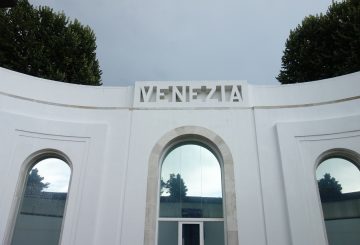Don’t ask the woman on the desk at the Australian Centre for Photography any questions. Don’t ask her, for instance, how the UNSW College of Fine Arts has become involved in the exhibition of Franco Zecchin, or in fact, what they are doing at all because although she says “they sponsored it” her eyes are saying “take a hike bozo”. Maybe she’s rattled by the show inside? We know we were.
In the hallway is the work of Jay Younger, a suite of works called Ulterior from 2002. Based on the patterns in Hawaiian shirts, Ulterior includes tiny, weeny pictures of celebrities from the Fitzgerald Inquiry, cops, crooks and politicians of yesteryear, spangled and dusted with sparkles in gay patterns and designs. It’s a jolly collection of works that seem a bit redundant in Sydney. You see this kind of thing all the time, especially in the windows of clubs on Oxford Street and in galleries around Mardi Gras time, and although they seem nice and fun, they’re also a bit tame. We gave them the once over and went into the main gallery.
This is where Franco Zecchin: Sicilian Chronicles is displayed. We’ve seen plenty of pictures of dead bodies before but this is quite different. Zecchin and his wife Letizia Battaglia, an anti-Mafia campaigner, moved to Palermo in 1975, one of the bloodiest periods of attrition in the war between the authorities and organised crime.
Zecchin was right there, on the spot, taking pictures of corpses in cars, in cafes, at home in their kitchens, slain in the street as they went for a walk or sitting in cafes, kids shot down off their motorbikes and scooters. Most of the time the victims were people who had crossed the Mafia. One incredible photo is of a man sitting in his shop, dead, his head tilted back, a river of blood coming from his face and right next to him is wife, alive and hysterical, crying. The picture looks like it was taken seconds after the shooting.
There other shots too, the collateral damage of the war; drug overdoses, shots of poverty and wrecked streets filled with rubble from bombs that, since Zecchin shot in black and white, make you think that the pictures were taken during World War 2 but actually date from the 1980s.
Zecchin is a photographer with an eye that seeks out startling compositions, moments chosen for their strange beauty and evocation of suffering. It came as no surprise to read in the room notes that the photographer joined Magnum Photo Agency and his work is reminiscent of war correspondents and those creepy death scene shots taken by the police in New York in the 19th century. What is most shocking in this show is the sheer repetition of forms, the way the bodies seem to blur and you are overcome by the number of deaths. This is a powerful show that demonstrates that art can still be socially engaged and banishes our thoughts about David Cheah to the realm of irrelevance.
Next door is the double DVD installation Dead Finks Don’t Talk and Catch (Struggle and Roll) by the Brisbane born artist Gina Torntore. Dead Finks Don’t Talk uses the song by Brian Eno as its title and were were drawn across the room by the song’s chu8nky 70s synthesizers. Anyone who uses early Eno is Ok by us.
The length of the song defines the duration of the work too, clocking in at 4.5 minutes. The images are concise, hands loading a gun, bullets dropping out of a box, a knife cutting a steak, a string being tied to the trigger of a revolver. On the opposite wall Catch (Struggle and Roll) is longer, at 15.5 minutes, it’s a long slow motion shot of two actors rolling down a slope, struggling against the incline. As Dead Finks Don’t Talk cycles around again and Catch (Struggle and Roll) continues, there seemed to be a direct relation between the two works.
We didn’t realise that the works were actually separate pieces, and we had built up in our minds an interesting relational schema between the two screens, remembering works like Shirin Neshat’s Rapture from the 2000 Sydney Biennale that artfully used multiple screens to extend narrative out of a single frame. Well, it was disappointing that they were two works but they seemed to fit so naturally together- and especially considering the installation’s juxtaposition with the Zecchin show and the title referring to dead informers – it all seemed to go together. Tornatore explains in her press blurb that she’s influenced by ‘classici Gialli’ (or Italian detective fiction to you and me) that apparently uses pop images and macabre juxtapositions. Throw in the artist’s love of early Punk and glam and you’ve got something pretty amazing.
On the way out of the ACP we stopped again and looked at Jay Younger’s Ulterior and felt so much better after the carnage in Zecchin and Torntore’s shows. Sure, it’s spangly and fey, but Australian crime seems so much more accessible and friendly compared to the means streets of Palermo. Bring back the green light!
We stood outside on Oxford Street and considered our next move when we saw the woman we had seen at breakfast, the one with the red socks and revealing cardigan. We were stunned to discover that she had gone home and changed, and was wearing a see-through top. Even the junkies in Paddington are fashion conscious.

